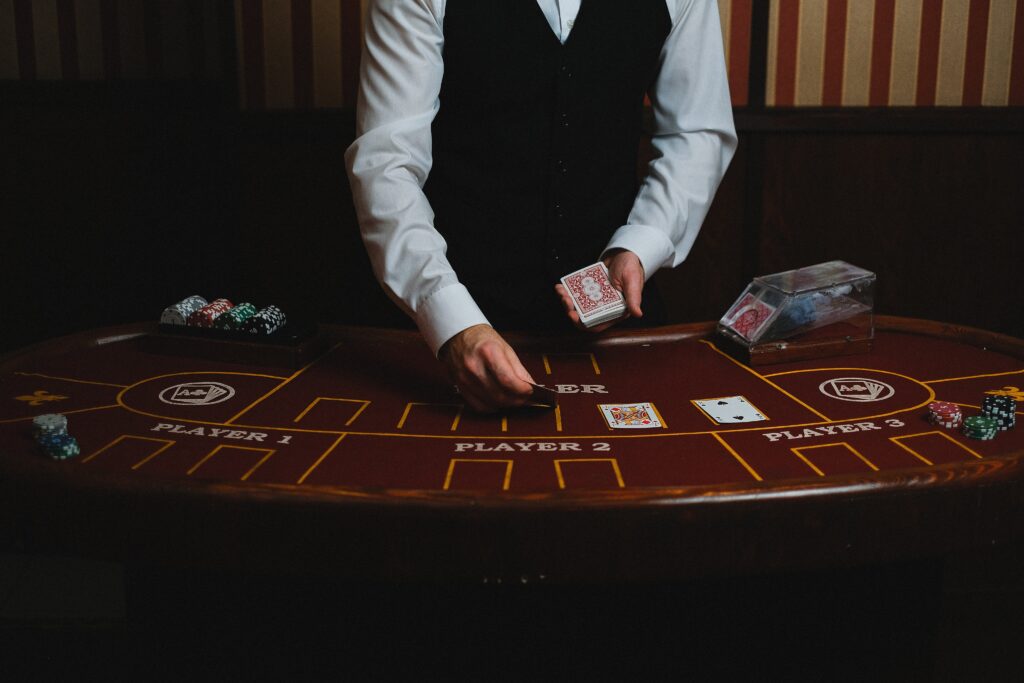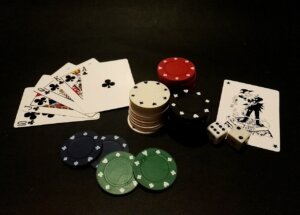Table of Contents
In poker, a “Straight” is a hand that contains five cards of sequential rank, although they don’t have to be the same suits. Aces can be high or low in a straight, but they cannot “wrap around.” A Straight beats Three of a Kind, Two Pairs, and One Pair but loses to a Flush and other higher hand combinations. There are 10 possible ways to make a straight in poker. Here they are listed from strongest to weakest:
- Ace-King-Queen-Jack-10
- King-Queen-Jack-10-9
- Queen-Jack-10-9-8
- Jack-10-9-8-7
- 10-9-8-7-6
- 9-8-7-6-5
- 8-7-6-5-4
- 7-6-5-4-3
- 6-5-4-3-2
- 5-4-3-2-Ace
As seen above, the higher-ranking cards the Straight is made up of, the stronger the hand is. Thus, a straight of 6-5-4-3-2 loses to a straight of 9-8-7-6-5. If two players have the same Straight, they’ll split the pot into two equal sizes.
Strategies for Playing a Straight

There are several ways to play a straight in poker. The most important thing is to know when you have a strong hand and when you don’t. If you have a strong hand, you want to bet aggressively to make the pot as big as possible. Conversely, if you have a weak hand, you want to check or fold to cut your losses.
Strategic handling of a straight depends on gauging your hand’s strength. For strong hands, aggressive betting increases the pot size, while weaker hands benefit from checking or folding to limit losses. General strategies include aggressive play for strong hands, adaptable choices for medium strength, and cautious actions for weak hands. Assessing table cards and anticipating opponents’ hands can improve success rates and reduce losses in poker games.
Some general guidelines for playing a Straight:
- If your hand is strong (top 10% of hands), bet aggressively on the flop. Raise or reraise if someone else bets into you. This is also beneficial if you have a so-called Open Straight (you’re only missing one card on the flop to complete your Straight)
- If your hand is medium strength (top 30% of hands), call, check, or raise, depending on the situation. Bet or raise on the flop if someone else has already bet into you. Check or fold if there is no action on the flop.
- If your hand is weak (bottom 60% of hands), check or fold preflop and on the flop unless there is heavy betting from other players indicating that they may have something stronger than you. In that case, call to see the turn card.
In general, it’s important to remember that you should play a Straight aggressively when you have a strong hand and cautiously when you don’t. Examine the cards on the table and understand which hand combinations can beat you and whether it’s likely that your opponent(s) could hold these hands.
Doing this can maximize your chances of winning pots and minimize your losses.
Probabilities of getting a Straight in Texas Hold ’em
The probability of getting a straight in poker depends on the specific variant of the game being played, the number of players, and the community cards dealt. In Texas Hold’em, for instance, the likelihood of flopping an open-ended straight draw (having four cards to a straight with the possibility of getting either end card to complete it) is roughly around 31.5% or about 1 in 3. In terms of completing an open-ended straight draw by the river, the probability is approximately 17.4% or around 1 in 6.
In Texas Hold ’em, the probability of getting a Straight depends on the number of possible combinations of cards that can make a Straight. Here are the probabilities of getting a straight in Texas Hold ’em based on the number of possible combinations:
- Open-ended straight draw (eight outs): approximately 31.5% or 1 in 3.18.
- Gutshot straight draw (four outs): Approximately 8.5% or 1 in 11.8.
- One-gap open-ended straight draw (four outs): Approximately 16.5% or 1 in 6.06.
- Two-gap open-ended straight draw (eight outs): Approximately 15% or 1 in 6.67.
Tips for Bluffing with a Straight

Since a Straight is a strong hand, many players will bluff and pretend they have a Straight even though they don’t. It’s especially favourable to bluff with a Straight when there’s a sequence of cards on the table, for instance, if the flop is 5-6-7.
When you’re bluffing with a straight, try to play the hand precisely like you would have if you actually had the hand! This way, your hand will look strong, and your opponents will likely fold.
Here are a few other vital things to remember when bluffing with a Straight in poker:
- Bet early and often. The earlier you bet, the more likely you are to get calls from weaker hands.
- Don’t be afraid to go all in. This will often put pressure on your opponents and make them fold.
- Pay attention to the table. If there are a lot of cards of the same suit, it’s more likely that someone has a Flush, and you might want to reconsider your bluff. Ultimately, bluffing with a Straight is all about timing and positioning. If you can determine the strength of your opponents’ hands and execute your bluff at the right time, you can win some big pots.
Summary – What Is a Straight in Poker?
In conclusion, a Straight hand in poker is one of the strongest hands you can have.
The hand comprises five cards of consecutive rank order, and it beats most other hand ranks except for a Flush or higher-ranking hands.
Straight hands come around fairly often, so don’t be afraid to go all-in if you think your opponent has nothing higher than your Straight. Similarly, do not be afraid to bluff and pretend you have a straight when you believe your opponent has a weaker hand.
With some practice and good strategy, mastering the concept of Straights will become second nature – allowing you to take full advantage when you hit this great hand at your table.
Tips for using a Straight in the best possible hand
Given the strength of a Straight in poker, numerous players opt to bluff, portraying possession of a Straight even when they lack one. Bluffing, especially effective when sequential cards appear on the table—like a 5-6-7 flop—can be advantageous. When executing a Straight bluff, mirroring genuine play is key. This lends credibility to your hand, often prompting opponents to fold. Additional crucial points to consider when bluffing with a Straight include initiating early and frequent bets to attract weaker hands, not hesitating to go all-in for added pressure, and staying attuned to the table dynamics, especially when numerous cards share the same suit—signalling a potential Flush. Successful Straight bluffing hinges on timing and positioning, enabling skilful assessment of opponents’ hands and strategic execution to secure significant pots.
The Art of Reading Your Opponents’ Hand
The ability to read your opponents’ straights in poker is a skill that requires observation, analysis, and an understanding of their playing tendencies. Pay close attention to how your opponents bet throughout the hand. Sudden aggression or rapid increases in betting could indicate a potential straight. If a sequence of cards appears on the board, watch for any sudden shifts in their betting behaviour. Evaluate the community cards on the table. If a potential straight draw is evident, observe whether your opponents are actively participating in the hand or are more reserved. Players who show interest in a straight draw may have connected with the cards.
Review how your opponents played their straights in previous hands. Do they tend to play aggressively or more cautiously when they have a straight? This insight can help you predict their moves in the current hand. Each player has a unique style. Some may be more conservative, while others are aggressive bluffers. Adjust your reads based on their tendencies.
If a normally cautious player suddenly bets heavily, they might have connected with a straight. The texture of the community cards matters. If the board is coordinated with cards in sequence, it’s more likely that someone could have a straight. For instance, a flop of 5-6-7 creates multiple straight possibilities.
Other Poker Hands

The straight is just one of many hands in poker. Below are some of the others:
1. A Royal Flush is the most powerful hand in poker. It comprises A, K, Q, J, and 10 of the same suit. This hand is extremely rare and is unbeatable by any other combination.
2. A Straight Flush is a sequence of five consecutive cards of the same suit. It ranks just below a Royal Flush and can vary in strength based on the highest card in the sequence.
3. Four of a Kind consists of four cards of the same rank, accompanied by any fifth card. This hand’s strength is determined by the rank of the four cards.
4. A Flush includes five cards of the same suit, not in sequential order. The highest card in the hand determines its strength. In case of a tie, the second-highest card, and so on, come into play.
5. Three of a Kind involves three cards of the same rank, accompanied by two unrelated cards. The higher the rank of the three cards, the stronger the hand.
6. Two Pair comprises two sets of cards of the same rank (e.g., two Kings and two Tens), along with any fifth card. The higher-ranked pair determines the hand’s strength.
7. One Pair features two cards of the same rank, with three unrelated cards completing the hand. The higher the pair, the better the hand.
Straight Variations in Different Poker Games
Different poker variants may have variations in how straights are treated and ranked due to variations in rules and hand combinations. In both Texas Hold’em and Omaha, a straight consists of five consecutive cards of any suit. The ranking of the straight is determined by the highest card in the sequence. Aces can be used as the highest card (A-K-Q-J-10) or as the lowest card (A-2-3-4-5) to complete a straight. In Seven Card Stud, the concept of a straight remains the same—a sequence of five consecutive cards. However, the hand might be comprised of a combination of face-up and face-down cards, adding a layer of strategy to forming and recognising straights.
Razz is a lowball variant where the objective is to have the lowest hand. In Razz, straights and flushes do not count against your hand, making them irrelevant in terms of hand strength. This means that A-2-3-4-5 is not considered a straight in Razz. In Deuce-to-Seven Triple Draw, straights and flushes are also not considered strong hands. The best possible hand is 2-3-4-5-7, and Aces are considered high. Straights do not count against your hand’s strength.
Etiquette for Playing and Announcing a Straight
When revealing your Straight, do so confidently and clearly. Make sure your hand is easily visible to other players and the dealer. This prevents any confusion or misunderstandings about the strength of your hand. Verbalise your hand clearly to prevent any ambiguity. Declare that you have a Straight, stating the highest card in your sequence. This makes it clear to everyone at the table what you’re holding.
In most poker games, you’ll need to reveal your hole cards if you’re declaring a Straight. This is to ensure transparency and uphold the integrity of the game. Show your cards face-up to the dealer and other players so they can verify your hand. If there’s an ongoing betting round, wait until it’s your turn to act before announcing your Straight.
FAQs
How do I strategize when playing a Straight?
When playing a Straight in poker, your strategy should revolve around assessing the strength of your hand in relation to the community cards and potential opponent hands. Depending on the board texture and your opponents’ behaviour, adapt your betting and actions to maximise value when your Straight is strong, while exercising caution and potential pot control when the board suggests possible higher hands.
Can I bluff effectively with a Straight?
Bluffing effectively with a Straight in poker is possible, but it requires a strategic approach. Bluffing with a Straight works best when the board shows potential for higher hands like Flushes or Full Houses, and your opponents’ actions suggest vulnerability to these hands, allowing you to represent a stronger combination and potentially force them to fold.






